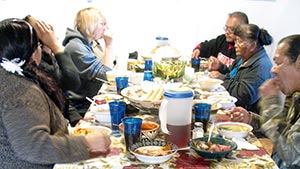'Eat good'
Jemez Pueblo opens its doors to feed anyone who attends feast day
By Summer Seschillie
Navajo Times
JEMEZ PUEBLO, Nov. 24, 2010

(Times photo - Summer Seschillie)
Visitors eat in the home of Clara Gachupin in Jemez Pueblo during the feast day in honor of the patron saint San Diego on Nov. 12.
In north-central New Mexico, about one hour northwest of Albuquerque, is the Jemez Pueblo, with a population of 3,400, which hosts hundreds of visitors in their village a few times each year.
On these days, known as feast days, the pueblo opens its doors to the public and, through a tradition that has been practiced for centuries, they feed guests with food such as kiva bread, green chili stew, and, this year, a unique and memorable Snicker fruit salad.
The village, which encompasses about a two-mile radius, is packed during feast days. On these days the people pay homage to a patron saint. On Nov. 12, the Jemez and Tesuque pueblos honored the patron saint San Diego, while renewing tradition through ceremonial singing and dancing in the streets of the village.
Walking randomly into a house is welcomed among people of the village. Clara Gachupin, 61, can testify of this since she has been doing it her whole life.
"My favorite part of this is the cooking," she said. "It's hard work, but we enjoy doing it."
Gachupin, who was born in a house in the village, and said she receives an equal amount of visits from regulars and strangers during feast days.
Gachupin prepared for the feast weeks in advance and started cooking two days before, anticipating 200 to 300 people in her home.
Asked how she could afford to feed such a huge number of people, Gachupin said the feast is a collective effort by village, through donating and gifting or trading.
"Are you hungry? Did you bring your appetite?" she said, laughing as she welcomed guests into her home, motioning for them to sit down in the living room as earlier guests finish in the dining room.
"It'll be just a few minutes, OK?" she said. "Sit down, and relax."
Jeri Smith, 54, a Braille specialist from Rio Rancho, N.M., is waiting on one of Gachupin's couches along with Derek Bronson, 24, and his wife Maura, 22, both from Albuquerque.
Smith came to the feast once before, at the invitation of Gachupin's husband James whom Smith knows through their work at Rio Ranch High School.
"I love the tradition and symbolism of this," Smith said. "I like how they open the doors to everyone. I wish we did this for Christmas. They're so loving and kind. It doesn't matter if you know the family or not."
"It's pretty selfless," Bronson said. "Our society is so focused on being so selfish. There's definitely an act of trust here."
Outside the village, Gachupin's daughter Janice, 41, is preparing food for visitors in her house as well. Janice, the self-proclaimed Snicker fruit salad creator, was denied time off from her job for the feast. She said even after submitting government documentation which supports her cultural heritage practice, she still had a hard time receiving time off.
"Eat good," she says repetitiously as people eat. "Thanks for coming."
When asked what type of etiquette is expected from guests who enter into the pueblo homes on feast days, Janice is not shy about voicing her opinion.
"Some people just come in and don't ask to eat," she said. "They just sit down and skip ahead of others waiting."
Janice says that even though it is tradition and her family enjoys feeding people, they ask that guests respect the tradition and first ask to come in to eat, rather than expecting to be waited on.
Also, she said, an offering is not required, but accepted. Offerings can be anything, from baking items to meat. Even non-food items are accepted.
"But you don't have to," she stresses. "We do this because we love doing it. This is why we do it, to feed you."
Kyle Thomas, 18, and Marcus Gray, 16, both Navajo, from Bloomfield, N.M., had never been to the feast before but said they enjoyed the food.
Thomas said he found out about the feast through the granddaughter, Tanisha, 14. This was the first time they met in person, since they initially met through a social networking site.
"It was kind of awkward," Tanisha said, giggling, of meeting the young men the first time.
Asked what she thinks of the feast tradition, Tanisha confidently replied that she intends to carry on the custom the same way her mother and grandmother have been doing.
"I would want to come back (after college) and continue the heritage of my ancestors," she said. "I don't speak the language fluently without getting help. I think it's important to continue the tradition."
Back in the village, Clara sends off her guests with a hug and a warm invitation to return. It is mid-afternoon, and she is looking forward to meeting more people as the day progresses.
Walking her guests outside, she gives directions on where to find their car.
"Be careful," she says, smiling. "It's a big village out there."

